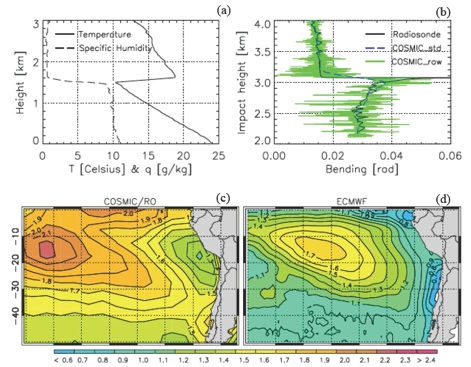Atmospheric Boundary Layer Research

The shallow atmospheric boundary layer (ABL) over the southeast (SE) Pacific Ocean is featured with a strong temperature inversion and a sharp moisture gradient across the ABL top, which is notoriously difficult to simulate in weather and climate models and is extremely challenge to measure from the space. The strong moisture and temperature gradients result in a sharp refractivity gradient that can be precisely detected by the high vertical resolution Global Positioning System (GPS) radio occultation (RO) bending angle and refractivity measurements (Fig. 1a,b).
The Constellation Observing System for Meteorology, Ionosphere & Climate (COSMIC) GPS RO soundings are capable to detect a wide range of ABL height variations (1-2 km) as observed from the ship-borne radiosondes collected during the VAMOS Ocean-Cloud-Atmosphere-Land Study Regional Experiment (VOCALS-Rex). The seasonal mean climatology of ABL heights derived from a nine-month composite of the COSMIC RO soundings over the SE Pacific reveals significant differences from the high-resolution ECMWF analysis (T799L91, with 25 km spatial resolution and 91 vertical levels). Both show the deepening of ABL height from the shallow stratocumulus near the coast to a much higher trade wind inversion further off the coast. However, COSMIC RO shows systematically higher ABL heights overall and reveals significant difference in spatial pattern as compared to the ECMWF analysis (Fig. 1c,d). Such discrepancy could imply deficiency in models ABL or shallow-cumulus parameterization schemes and would require further investigation.

